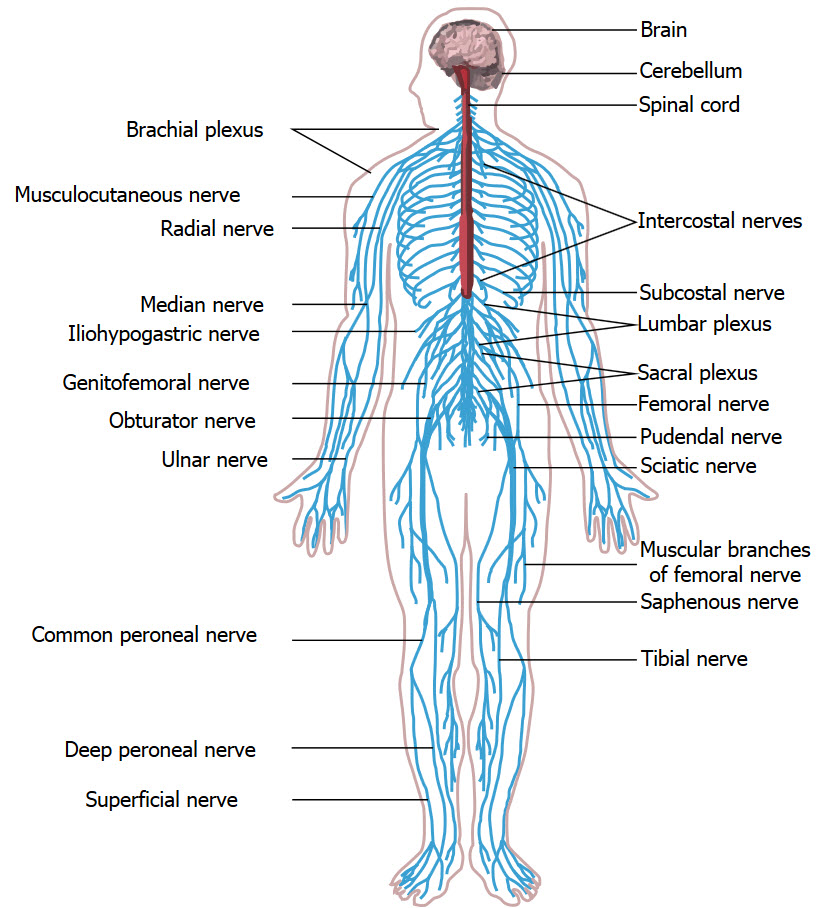 Your Nervous System
Your Nervous System
Your brain, quietly floating in your skull, appears to be doing nothing, yet it processes billions of bits of information every second about what’s going on, in and around you, every moment. It sends out billions of commands: how fast your heart should beat, blood chemistry changes, blood pressure, how to throw a football, bake cookies and what to wear. It’s through your brain that you remember millions of memories and express the plethora of feelings, moods, emotions and inspirations that make you uniquely you.
At the bottom of your skull is a large hole called the “foramen magnum.” Your brain extends through this hole as a cable of billions of nerve fibers that become your spinal cord. Spinal cord nerves connect your brain to your heart, lungs, arms and legs. That’s how you know that a mosquito is on your ankle.
You’re Covered In Nerves
Your nerve fibers are so numerous that if all your skin, bones, muscles, blood vessels and organs were to vanish and only your nerves were to remain you’d still be recognizable!
Protection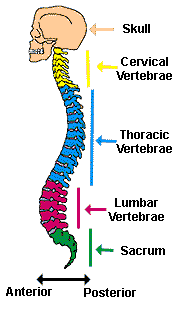
Your brain and spinal cord are very delicate. Since brain damage can be permanent, your soft brain is surrounded by hard bone to protect it. If your spinal cord were protected by solid bone you wouldn’t be able to bend or twist. Instead it is surrounded by spinal bones that are stacked up like a pile of bagels or donuts (with the center holes forming a “canal” through which your spinal cord passes).
However, with flexibility you give up a bit of protection. Your spinal bones may slip out of position and damage or stress the very nerves they are designed to protect. This condition is called a subluxation and chiropractors are trained in locating this nerve-damaging condition.
Your Spinal Column
When ancient Greeks looked at people’s backs they saw bumps and thought they resembled thorns so they called them spina—Greek for thorn. The individual bones of your spina or spine are called vertebrae from the Latin vertere, to turn. Your vertebral or spinal column is your “backbone” and it is divided into 5 sections:
cervical, thoracic, lumbar, sacrum and coccyx.
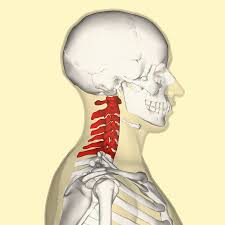 Cervical (Neck) Spine
Cervical (Neck) Spine
Under your skull is your first cervical vertebra or atlas—it holds the globe of your skull as the god Atlas held the globe of the earth. Your second cervical vertebra is called the axis because it permits a lot of head turning and tilting. Your “cervicals” also have numerical names: atlas is C-1, axis C-2, the third is simply C-3, then C-4,
C-5,C-6 and C-7.
Thoracic (Mid-back) Spine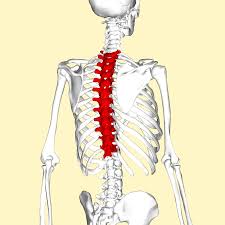
You have 12 thoracic vertebrae named (you guessed it) T-1,T-2,T-3 to T-12. The ribs are connected to them and if you follow the path of your ribs around from your front or sides to your back you can feel where they attach. They attach in front to your sternum or breastbone.
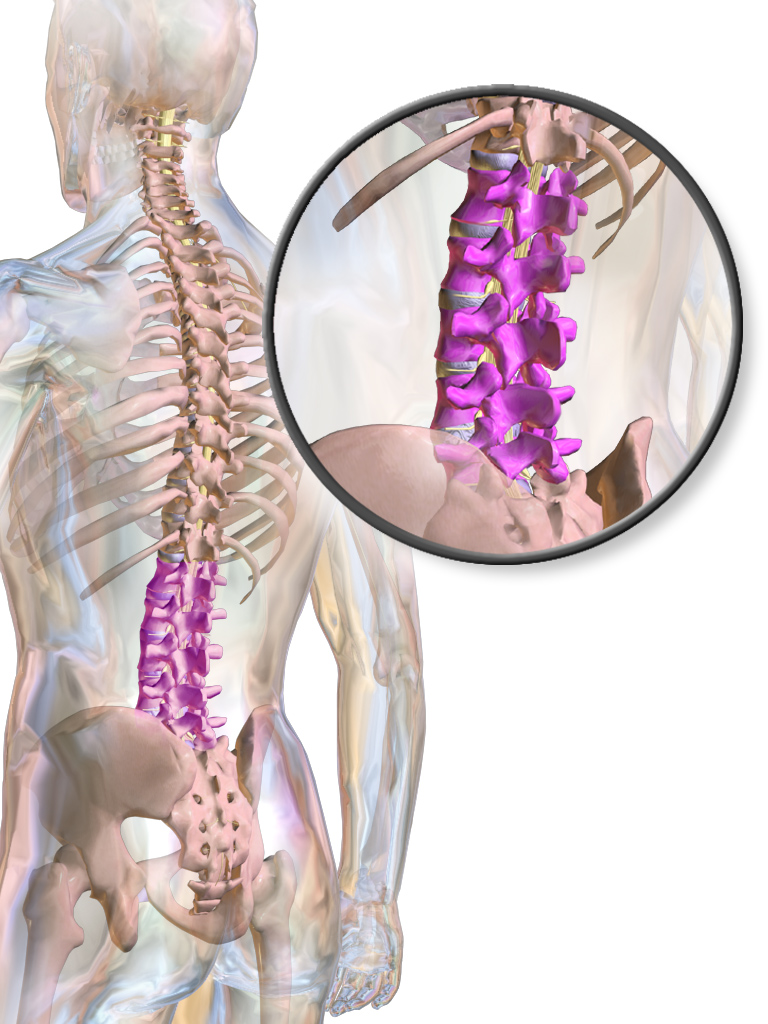 Lumbar (Lower Back) Spine
Lumbar (Lower Back) Spine
Most people have five lumbar vertebrae. They are the biggest, thickest and most massive of all your vertebrae because, being at the bottom of your spine, they have the most weight to hold up. That’s a big reason lower back pain is very common.
Sacrum
Under the lumbar vertebrae is the sacrum, a triangular shaped bone made up of five fused vertebrae. Sacrum is from the Latin word for “sacred” because this portion of an animal was used in sacrifices. The sacrum connects to the hips on either side. And under the sacrum we find:
Coccyx (Tailbone)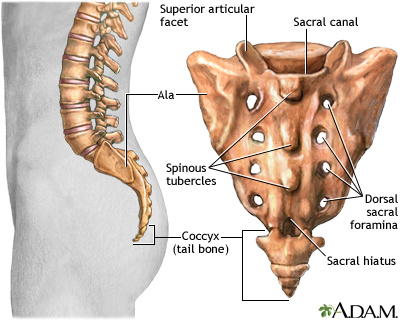
The bottom of your spine is a little bone made up of three or four fused vertebrae called the coccyx. It is what’s left of the human tailbone. Occasionally human babies are born with extra coccyx bones that grow outside the body—a human tail. They are easily surgically removed.
Discs
Between most of your vertebrae are pads called discs that act as little cushions or shock absorbers so your vertebrae won’t bump into each other while you walk, bend and run.
Your Spine
7 Cervical (neck) vertebrae
12 Thoracic (mid-back) vertebrae
5 Lumbar (low back) vertebrae
1 Sacrum (five fused vertebrae)
1 Coccyx (three or four fused vertebrae)
Functions
Your spinal column has 4 main functions:
- To protect your brain and spinal cord.
- To support your hips, legs, shoulders and arms.
- To serve as attachments for muscles, permitting you to stand and move.
- To support your head and ribs.
If your spine becomes unbalanced, it stresses your bones, spinal cord, brain and other nerves and causes pain, fatigue, weakness and dis-ease (loss of health or wholeness). Your chiropractor is able to locate this unbalance called a subluxation and realign your spinal column to remove stress from your nerves and bones, thus helping to restore health and wholeness to your body.
To have your spinal balance checked at Performance Chiropractic, call us at (661) 942-5000. Your body will thank you for it!




FOLLOW US!